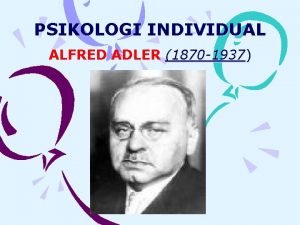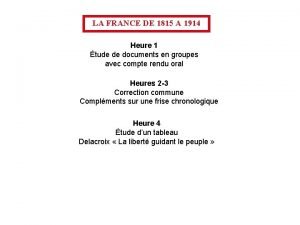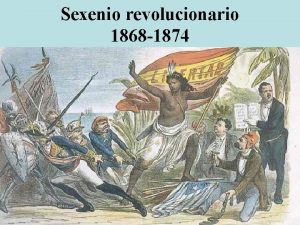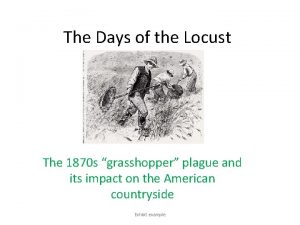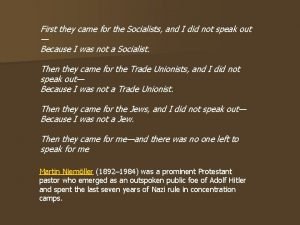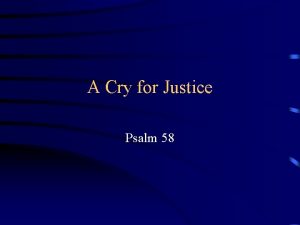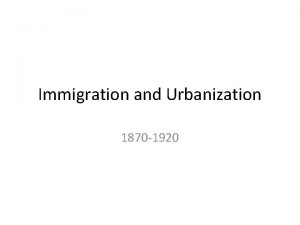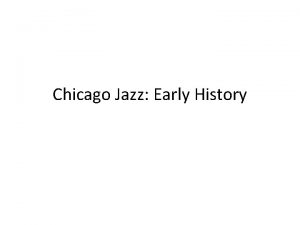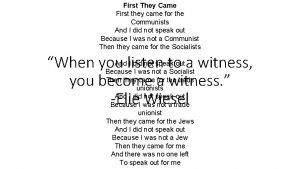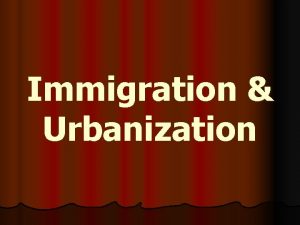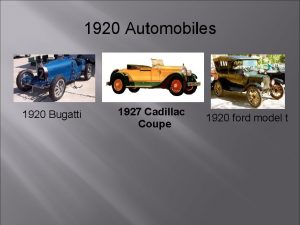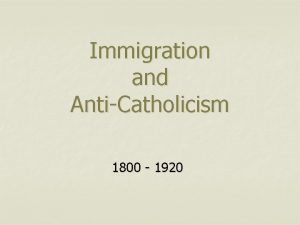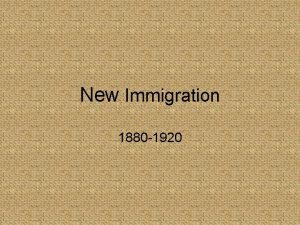Chicago 1870 1920 IMMIGRATION ITALIANS First came to
















- Slides: 16

Chicago 1870 -1920 IMMIGRATION

ITALIANS � First came to Chicago in the 1850 s in small numbers, by 1920 there were 59, 000 Italianborn people in Chicago. � Most Italian immigrants came from southern and central Italy and were very poor. � Called contadini

WHAT MADE ITALIANS DIFFERENT? � Planned temporary stays in America � Wage-earning � Found male, work here 5 years, go back work through the padrone system � Italian labor-broker who spoke English, would help them find work � Practiced � Entire campanilismo villages would come here together

ITALIAN NEIGHBORHOODS Largest was on Near West Side near Taylor Street and Hull House. Also lived just south of the Loop and on Division Street on the Near Northwest Side. Men without families lived in overpopulated buildings, slums.

ITALIANS Preferred to work outdoors Unskilled jobs: railroad labor, construction work, fruit and vegetable workers Early immigrants were not interested in the Catholic Church Many went back home ITALIANS VS. POLES Worked indoors in industrial factories The Catholic Church was very important to the Polish community. They did not go back to Poland

EASTERN EUROPEAN JEWS � 10, 000 Jews in Chicago as of 1880 � Highly � 70, 000 assimilated, Germans by 1900 � 275, 000 by 1930: now the 3 rd largest Jewish population of any city in the world � 80% came from Eastern Europe: Russia, Poland, and Austria-Hungary.

JEWISH NEIGHBORHOODS Originally settled around Maxwell and Halsted Also settled in East Rogers Park Worked as street vendors and door-todoor salesmen

JEWISH ASSIMILATION � Upward mobility, usually within one generation � Eastern European Jews acted and dressed much differently than German Jews who’d been here for decades � Established institutions like the Chicago Hebrew Institute in 1908 � Jews had no desire to return to Europe due to anti. Semitism they faced there

GREEKS By 1910 there were 15, 000 Greeks living in Chicago Settled on the Near West Side in Greek Town bordered by Halsted, Harrison, Blue Island, and Polk. Artisans and Merchants, successful

CZECHS AKA Bohemians first came to Chicago in the 1850 s. By 1910 there were 110, 000 Czechs in Chicago, second only to Prague. Settled the neighborhood of Pilsen

CZECHS CONT’D � Not as poor as other new immigrants � Educated and literate � Came here permanently and had an insatiable desire to own property � Founded Building and Loan associations � Got along well with other ethnic groups and did not vote as a bloc.

ANTON CERMAK • Former Congressman, elected Mayor in 1931, defeated “Big” Bill Thompson. Was assassinated in 1933 in what was believed to be a failed assassination attempt on FDR. • 22 nd Street was renamed Cermak Road in his honor.

SWEDES AND SCANDINAVIANS � Swedes, Norwegians, and Danes first came to the city between 1840 and 1870. � After 1870, the Swedish population in Chicago grew large: 20, 000 by 1880 and 121, 000 by 1920. � By 1880, the Swedes had already established a strong community in Chicago � 13 churches in the city by 1880 � Was easier for later generations of Swedes to come here

SWEDES SETTLED Originally settled in what is now River North and the Near North Side Many avoided the downtown slums and moved to outlying areas of the city or enclaves such as Andersonville

THEMES � All major U. S. cities saw an influx of immigrants from 1870 -1920. But by 1900, Chicago had the most Poles, Swedes, Czechs, Dutch, Danes, Norwegians, Croatians, Slovaks, Lithuanians, and Greeks than any other U. S. city. � Shared many common experiences: did not want to lose ethnic cultures, churches, schools, etc…

THEMES CONT’D � By the second and third generations of all ethnic backgrounds, many immigrant families were assimilated � � Some more than others No government assistance for these turn-of-thecentury immigrants. � Worked hard, helped each other � Role of the Church and Synagogue in the community � Role of the saloon
 Irony in the rime of the ancient mariner
Irony in the rime of the ancient mariner 1870
1870 John brown the martyr currier and ives 1870
John brown the martyr currier and ives 1870 Frise chronologique 1815 à 1870
Frise chronologique 1815 à 1870 ‘over land by rail’, gustave dore, 1870
‘over land by rail’, gustave dore, 1870 Contoh striving for superiority
Contoh striving for superiority Frise chronologique 1815 à 1914
Frise chronologique 1815 à 1914 Rey de españa entre 1870 y 1873
Rey de españa entre 1870 y 1873 Maria montessori father
Maria montessori father 1870 locust plague
1870 locust plague Strengths and weaknesses of the forster act 1870
Strengths and weaknesses of the forster act 1870 Halyna kuzmenko
Halyna kuzmenko When i first came to this land i was not a wealthy man
When i first came to this land i was not a wealthy man What came first the chicken or the egg
What came first the chicken or the egg Holocaust poem first they came
Holocaust poem first they came What is the theme of first they came for the communists
What is the theme of first they came for the communists Internal services
Internal services





